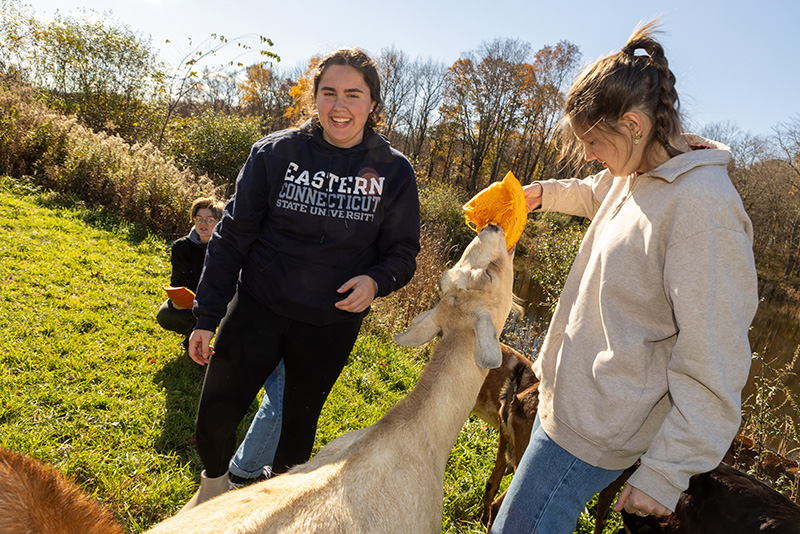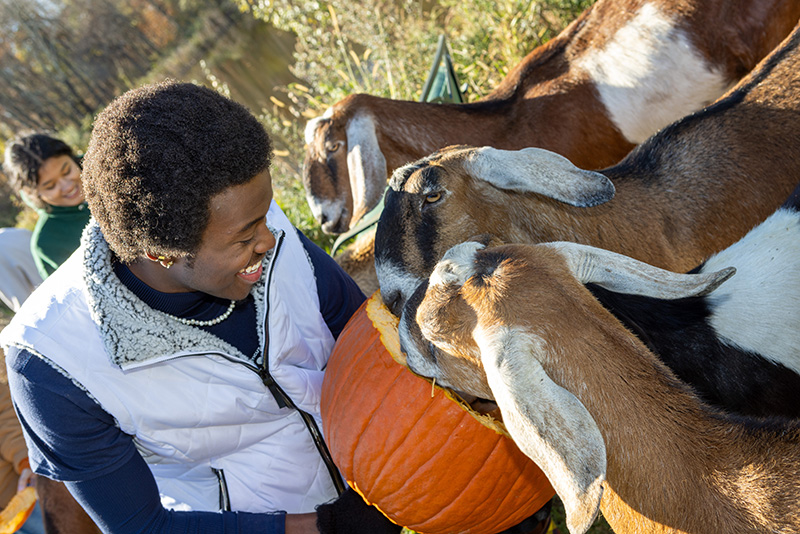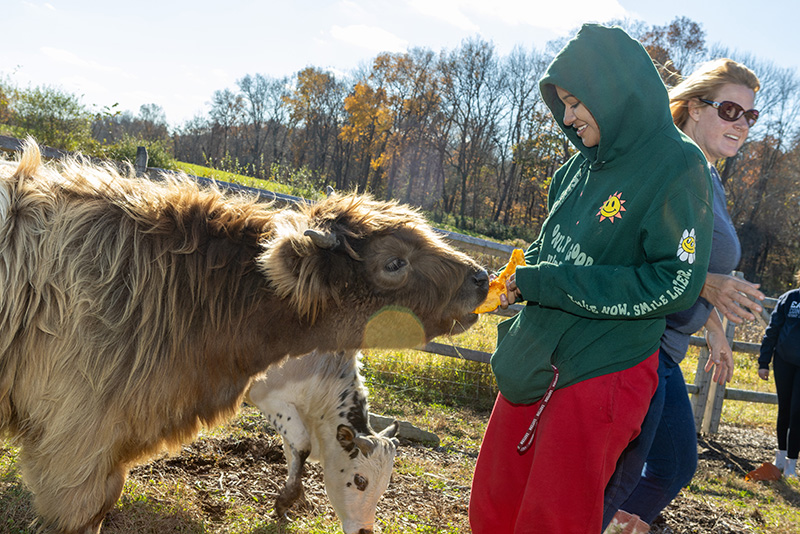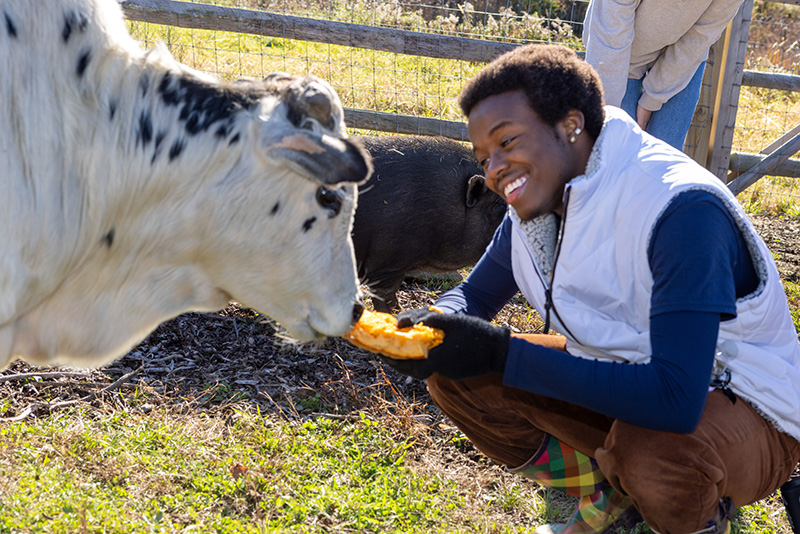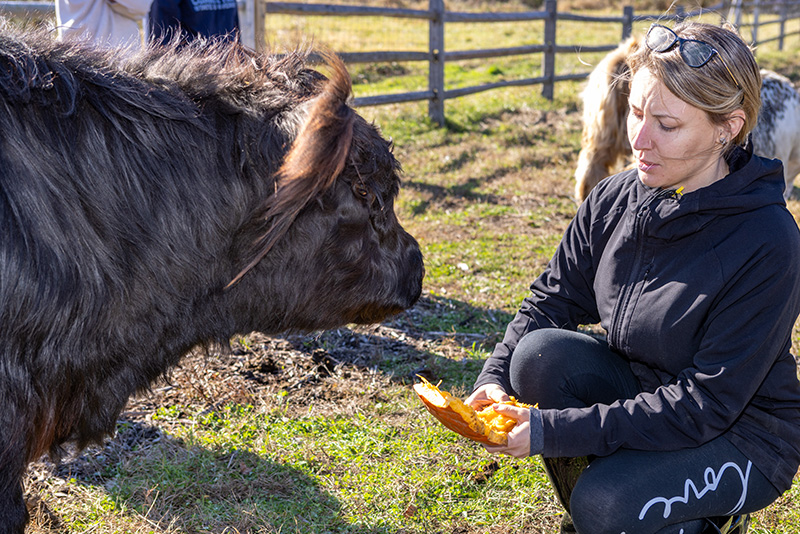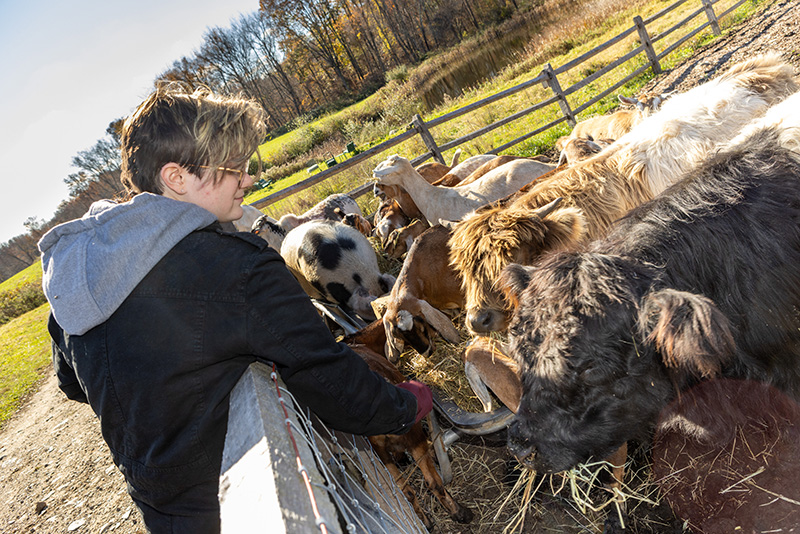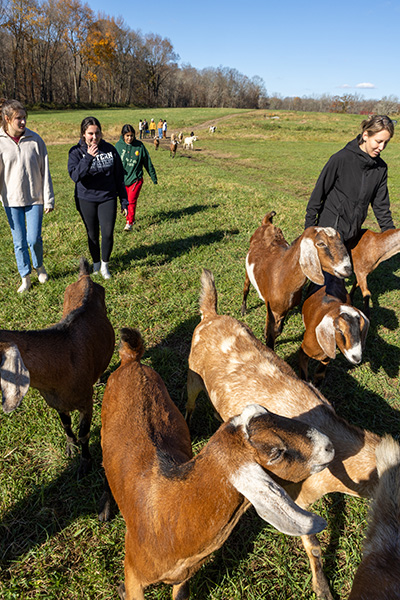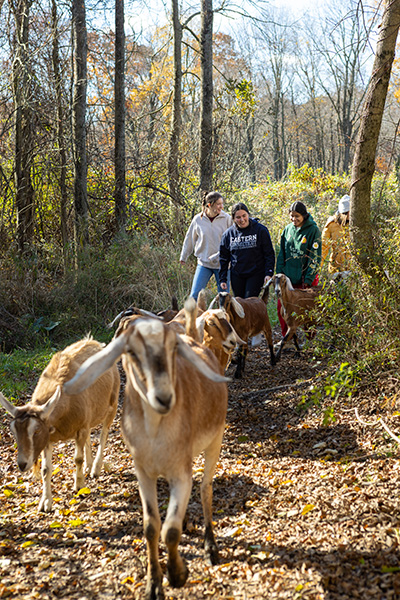- Apply
- Visit
- Request Info
- Give
Helping animals helps students
Eastern students volunteer at animal rescue and retreat farm
Written by Lucinda Weiss
Published on November 09, 2023
Helping other people in the community is the focus of most of the programs at Eastern Connecticut State University’s Center for Community Engagement (CCE). But a new program this fall has Eastern students volunteering to help (among others) a 550-pound spotted pig, a miniature Zebu cow, eight hens known as “The Ladies” and three draft horses.
The students volunteer at Blue Iris Farm Rescue and Retreat in Lebanon, a 114-acre farm where abused or unwanted farm animals find shelter and care. The 60+ animals at the farm, in turn, make human visitors to the farm “so happy,” said Jamie Collins, who started the farm in 2021 with her husband Bob Doyle, who passed away from COVID after they bought the land.
After taking a year off to grieve, Collins has opened the farm to visits from senior citizen groups, people with autism and anyone who wants to re-connect with nature and animals.
“I know it helped me with my grief — I think it helps them,” she said.
The Eastern students who work there, helping to feed, clean and care for the livestock and assist Collins with marketing efforts, are often animal lovers themselves.
Meghan Wrobel, a junior, is a student CCE leader who brings a group of nine student volunteers to the farm on Thursdays. Wrobel attended a Vo-Ag high school in Voluntown and studied animal science, where they had experience working with goats, sheep and horses. Now a digital art and design major at Eastern and a graphic design intern at the CCE, Wrobel designs fliers and social media marketing with Collins, who wants to make the farm a “destination experience.” The farm has trails and craft lessons in a “fairy cottage” built by Collins and her daughter and scenic spots where visitors can picnic or relax.
Wrobel, like the other student volunteers, also feeds and works with the animals. “We have neuroscience, psychology, education and biology majors” Wrobel said of the volunteer group. “Each person has a different reason for why they want to do it. It’s a really cool experience for people who want to work with animals,” they said.
The animals all have names. Blue is the miniature Zebu. Iris is the 550-pound bacon pig. Henry and Harper are two pigs who were donated by a woman who rescued them and kept them in a garage but could no longer care for them. Moo, a small pig, was beaten and was afraid of men when first arriving at the farm but now wags its tail at the students. Love and Sosa are belted Highlands cattle. “The Chicken Inn” henhouse is the home of Penelope, Lycille, Fluffy, Beyonce, Halo, Charlotte, Hazel and Henrietta.
A herd of goats follows the students around the farm, always in search of food, and the students know their names — Braden, Sage, and dozens more. The goats were especially taken with a special treat at a recent visit — cut-up pumpkins.
Didismay Yedra, a second-year psychology major and one of the volunteers, is doing research on the effects of farm animals on mental health. Studies in Norway, where animal care farms are part of mental health treatment, found that being on care farms decreases anxiety and depression in humans and increases self confidence, she said. People with disabilities and older people with dementia have also shown benefits from being around farm animals. The benefits seem to come not from contact with the animals but from the farm environment and helping with daily tasks there, she said.
Alexandra Levesque, a senior from Thomaston who volunteers at the farm, “always wanted a farm,” she said. She grew up in Thomaston in a family that had four dogs and three cats. Now a sociology and criminology major, she hesitated about choosing a veterinary career path because she was afraid she would not be able to put animals down.
Meghan Georgescu, a sophomore biology major who plans to become a veterinarian, is a CCE student leader who brings a group of volunteers to the farm on Tuesdays, where they sometimes assist a local veterinarian. Georgescu said the experience of working with large animals may help her in the competitive process of getting into veterinary school. She also volunteers at a small animal veterinary practice in Cheshire.
As a first-year student, she worked on other CCE programs, such as volunteering at the No Freeze shelter and the Connecticut Community for Addiction Recovery, but she wanted to find a volunteer program in animal care. After conducting research, she connected the CCE with Blue Iris Farm, organizing the program last summer.
The volunteer tasks at the farm range from changing water to feeding animals, learning how to administer shots and other farm tasks such as helping to build a stone wall.
“It’s very different from other CCE programs,” she said. “People find it super healing to be with animals in that kind of setting.”
Collins, who runs the farm with the assistance of her two grown children, said being at the farm has been a welcome retreat for students when they are under the stress of midterms, for example. While students help with the animals, what the animals provide for their human visitors is equally important, she said.
“What they give back to us is even more than I imagined,” she said.



